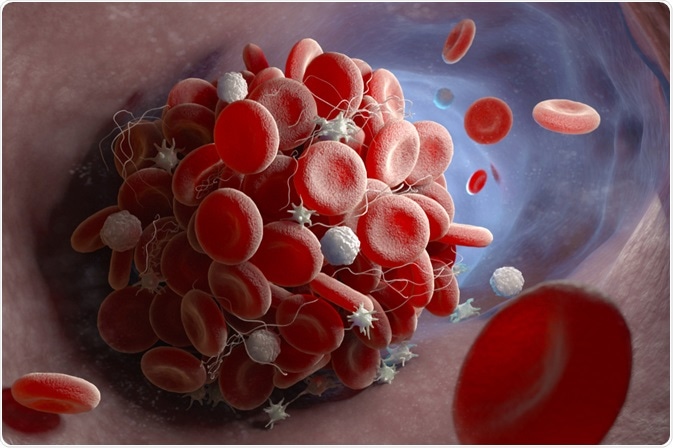What is hemostatic testing?
Hemostasis is the physiological process in which bleeding is stopped at the site of injury while preserving blood flow elsewhere within the human body (opposite of hemorrhaging) and is an essential primary step in wound healing.

Image Credit: Tatiana Shepeleva/Shutterstock.com
Hemostatic testing screens patients who may possess hemostatic defects that result in excessive clotting or bleeding, such as thrombophilia (excessive clotting) and hemophilia (inability to clot). These defects can be acquired or inherited.
Hemostasis consists of two main pathways; primary hemostasis and secondary hemostasis. In brief, it comprises of vasoconstriction, the formation of the platelet plug, fibrin clot formation, and fibrinolysis. Vasoconstriction is the process that blood vessels become narrow to reduce blood flow to the site of injury.
The formation of the platelet plug (primary hemostasis) is to stop the bleeding at the injury. The fibrin clot formation (secondary hemostasis), also known as blood coagulation, is formed through the activation of the coagulation cascade, this forms a mesh around the platelet plug to hold it in place.
Fibrinolysis is the process in which the clot is broken down by enzymes thus preventing it from becoming problematic.
Hemostatic screening tests are vital for providing physicians with essential information on how a patient may respond when undergoing surgical procedures.
Hemostatic tests provide information on all aspects of hemostasis, these tests are primarily; prothrombin time, prothrombin time ratio activated partial thromboplastin time, activated partial thromboplastin time ratio and fibrinogen.
There are further tests that may be carried out if necessary. Hemostatic tests are important in predicting patients that may have excessive clotting or defective clotting which is especially vital in preventing post-surgery complications.
The automation of hemostatic testing
Recent years have seen the advancement of the use of robotics in the laboratory setting.
The use of automation allows for many processes that once required a considerable amount of resources dedicated to them, such as time and human workers, to be conducted at faster speeds, with greater levels of consistency, permitting the conservation of time and human resources within the laboratory.
Hemostatic testing is one such procedure that laboratory robotics has automated. Previously, it has been explored whether the process of analyzing hemostatic samples could reliably be automated.
The key concern was the vulnerable nature of the samples; they are prone to detrimental impacts via the movements that automation introduces to samples, such as track, belt, or conveyor transportation.
Early studies demonstrated that robotic handling might potentially affect the quality of the hemostatic testing results.
Samples for hemostatic testing are centrifuged before analysis. Automated transportation systems of these centrifuged samples may cause the partial resuspension of pellet cells within the upper plasma phase. This has been of concern when the samples were transported at high speeds.
Previously, automated systems have been compared to manual direct loading into the analyzer. Although significant differences were found between the samples that were directly loaded into the analyzer compared to samples that were entered via the automated track-line system, the results of the track-line system were still within the total allowable error.
It was demonstrated that the processing of plasma samples through extensive track-line systems affects the results of routine hemostasis testing. Nevertheless, as the differences were not clinically significant, the automated processing of hemostasis testing remains a viable option.
The impact of movement on the samples must be considered to limit the negative effects on the quality of the results.
Future challenges
There have been advancements in the automation of hemostasis testing. Currently, automation is being adopted clinically due to its numerous benefits including; consistency, faster turnaround time and reduced overall cost.
Furthermore, there are several additional indirect benefits such as permitting the allocation of skilled staff to other areas, further reducing costs and an improvement in patient care.
For automated hemostasis testing to become widely adopted in the future, current challenges need to be considered.
The high cost of maintenance, the dependence on IT and the manufacturer and the reduced flexibility of the testing process need improvement. The set-up costs of automation systems are high, which may prevent laboratories from investing in automation equipment.
Sources:
- Chapin, J. C., & Hajjar, K. A. (2015). Fibrinolysis and the control of blood coagulation. Blood reviews, 29(1), 17–24.
- Da Rin, G., and Lippi, G. (2014). Total Laboratory Automation of Routine Hemostasis Testing. Journal of Laboratory Automation, 19(4), pp.419-422.
- Funk, D. M. A., Lippi, G., & Favaloro, E. J. (2012, September). Quality standards for sample processing, transportation, and storage in hemostasis testing. In Seminars in thrombosis and hemostasis (Vol. 38, No. 06, pp. 576-585). Thieme Medical Publishers.
- Gale A. J. (2011). Continuing education course #2: current understanding of hemostasis. Toxicologic pathology, 39(1), 273–280.
- Méndez, A., Brunner-Agten, S. and Huber, A. (2013). Automation in hemostasis. Hämostaseologie, 33(04), pp.295-298.
- Raber, M. N. (1990). Coagulation tests. Clinical Methods: The History, Physical, and Laboratory Examinations. 3rd edition. Butterworths.
Further Reading